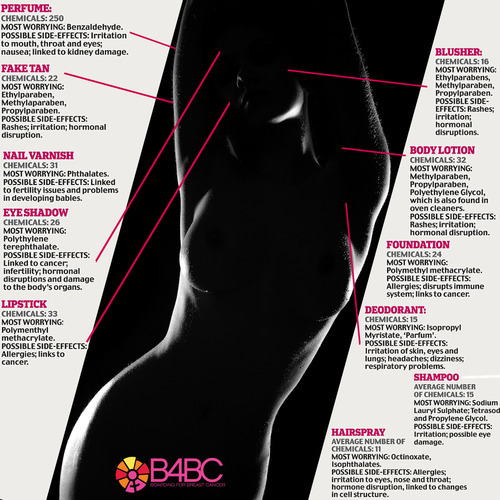
Did you know the average woman wears 515 chemicals a day? 5-1-5. What?! Of the 82,000 ingredients found in beauty products, one in eight is an industrial chemical. Our skin absorbs 60 percent of any topical product we use, which often contain chemicals linked to cancer or hormone disruption.
Advertisers spent an astonishing $144 billion in 2011 to entice shoppers to buy more and more stuff, and there is shockingly little regulation on how they are able to label their products, and what toxic chemicals go in them.
So educate yourself! It’s important to know that using one product with chemicals in it is not guaranteed to give you cancer, but small doses of exposure to many chemicals over time does increase your risk. And the tricky part is that everyones bodies, exposure and genetics are different so you don’t know what your risk is to start.
Here is a super informative graphic detailing the chemicals to avoid (click here for full size infographic), and read up on some of the most important key points:

In an article posted in BlogHer.com, Kamila does a great job summing up these 5 chemicals to watch out for:
Phthalates
Phthalates are a family of chemicals that are used in just about all artificially scented products on the market today. This includes air fresheners, scented body products and of course perfumes. They are used to help stabilize the fragrance chemicals.
These chemicals are most commonly used to soften plastics and are found in products such as hair straighteners, hairsprays, and nail polish.
Studies have concluded that phthalates likely contribute to early-onset menopause and may also contribute to infertility in women and men. They can have a definite impact natural hormones circulating in the body, and have shown the ability to reduce circulating sex hormones.
In other words, they tamper with your body’s natural ability to control its natural balance of female and male sex hormones. Some of the ways you may see phthalates on the ingredient label are as di-n-butyl phthalate (DBP) and di(2-ehtylhexyl) phthalate (DEHP).
Amine
You’ve likely seen offshoots of this popular chemical additive in the ingredient list of products purchased in the past. They can be found listed as diethanolamine (DEA), triethanolamine (TEA), amonoethanolamine (MEA) on the ingredient label.
These chemicals are commonly used as an emulsifier for stable mixtures, as foaming agent in bar and liquid soaps and shampoos, and as a preservative for long shelf life. They are not only linked to hormonal disruption, but they are also linked to liver and kidney cancer and are corrosive to the delicate eye tissue.
Nonylphenol or nonylphenol ethoxylates
These chemicals are found in many commercial hair colors and dyes as well as in laundry detergent and household cleaners. They can usually be found on the ingredient label as 4-nonylphenol, an alkylphenol. These chemicals act like female estrogen in the body and can throw both the male and female body out of their natural hormone balance.
Parabens
Parabens are preservatives that are present in many body and hair care products. This family of chemicals is found on the ingredient label with the prefixes of “methyl,” “ethyl,” “propyl” and “butyl.” Parabens are a well known endocrine disruptor with a documented history of causing hormonal issues because of their ability to mimic the female hormone, estrogen.
Triclosan
Triclosan is an antibacterial agent that was added to specially formulated soaps and hand sanitizers specifically marketed for antibacterial use. They are highly disruptive to the human endocrine system and several links to cancer have also been raised over the past several years.
Simply put, there is no universal standard dictating that companies must share their ingredient lists with consumers. There are also no legal standards in regards to using words like “natural” on cosmetics bottles. It’s a great marketing catch phrase, because natural cosmetics are in the fastest-growing sales category, but it doesn’t actually mean anything because there are no criteria that companies developing products have to meet before being declared “natural”.
This untruth in advertising is called “greenwashing” and it is very common in the personal care industry. But there are some strides being made. Organizations like The Campaign for Safe Cosmetics have been lobbying for transparency in the industry and advocating for legislation like the Safe Cosmetics Act of 2011.
In the meantime, there is plenty you can do to in order to personally combat the commerce of toxic personal care products. Check out handy online references like this guide to safe, non-toxic makeup when you make your purchasing decisions. If you’re out shopping without the benefit of being able to go online and research the ingredients in the product you’re thinking of buying, The David Suzuki Foundation has identified some of the most common chemicals that frequently crop up on cosmetics labels and dubbed them the “Dirty Dozen”. You can print out a handy shopping guide of these toxins to reference while shopping.
The Environmental Working Group also has a quick reference guide available which includes handy tips on how to cut down on unnecessary beauty product use altogether. Are you already committed to certain brands, but you’re not sure how safe they are? Visit the Skin Deep Database to investigate the potential toxicity of your favorite products. If you’re uncomfortable with the level of chemicals present in your go-to goodies, you can also use this database to find better alternatives for those that are unsafe.
Stay chemical free, friends!
xx,
Liza
Still have questions? Visit www.b4bc.org, www.pureprevention.org or www.ewg.org or email Liza@b4bc.org for more info!
Sources:
http://www2.epa.gov/toxics-release-inventory-tri-program/2012-tri-national-analysis
http://www.campaignforsafecosmetics.org
http://www.refinery29.com/toxins#slide-2
http://www.mindbodygreen.com/0-11706/10-toxic-products-no-one-needs.html
http://www.mindbodygreen.com/0-1564/Cosmetics-Dirty-Dozen.html







